A Budget Home Theater & PC Setup: 4K, HDR, UHD Blu-ray, and More
by Ganesh T S on December 26, 2017 8:30 AM ESTLocal Media Playback
Our typical HTPC testing flow involves playing back files encompassing a range of relevant codecs, containers, resolutions, and frame rates. A note of the efficiency is also made by tracking GPU usage and power consumption of the system at the wall. Over the last year or two, the focus has been on using Kodi and MPC-HC with its built-in LAV filters for benchmarking. Even though we have had non-HDR 4K clips for some time now in our test suite, we have not subject them playback at native resolution. In order to augment our test suite, we have added two files, a 4Kp25 HEVC HDR stream in a MKV container, and a 4Kp60 VP9 Profile 2 HDR stream in a WebM container.
Out of all the options we evaluated, the TCL 55P607's in-built Roku platform is the only one capable of handling Dolby Vision videos. However, when we tried to play back a sample file, the Roku interface stalled in the retrieving stage after the appearance of the Dolby Vision logo.
The TCL 55P607 Roku Media Player App - Unable to Handle Local Dolby Vision Files
Due to the absence of reliable open-source editing and decoding tools for Dolby Vision in the PC space, its testing with local media files will have to wait.
The Roku Media Player app continues to be a disappointment for users with anything other than the standard H.264 / HEVC-based camcorder files. The following recorded clip shows its failure with some interlaced MPEG-2 and H.264 clips in TS containers. VC-1 is also not supported.
On the plus side, we have automatic switching to HDR for local files which have HEVC HDR content. On the othr hand, a VP9 Profile 2 HDR clip did not generate the mode switch.
We tracked the power consumption of the TV while the Roku interface tried playing back the various files in our test suite. It was not much of a surprise to find that Roku fails to play back many of the streams. The graph segments below corresponding to the files that didn't play back are just the display remaining idle in the Roku USB Player interface.
The NVIDIA SATV supports all files in our test suite except the one encoded in VP9 Profile 2. With Kodi, we even see the HEVC HDR file being decoded and sent to the display with the appropriate mode switch.
The NVIDIA SHIELD Android TV Supports HDR Playback with Local Files
The power consumption of the SATV was tracked during the playback of each file in our test suite using Kodi 17.6. The segment corresponding to the VP9 Profile 2 file is just the duration for which the audio track was decoded and the Kodi UI remained idle.
Moving on to the PC space, we first compare the DXVAChecker outputs for the three systems. The Zotac EN1080K with its GTX 1080 GPU does not support hardware decoding of VP9 Profile 2 videos. Even if a HDR stream were to be available, the system plays back only the non-HDR versions with the desktop in HDR mode.
The Absence of VP9 10-bit Profile 2 Decoding in the GTX 1080 is the Only Odd Spot (from L to R: ASRock Beebox-S 7200U, Zotac ZBOX MAGNUS EN1080K, and the Intel NUC7i7BNHX1)
We found the native Microsoft Movies & TV app to be capable of playing back HDR videos with the desktop in HDR mode. A comparison of playback using two different players in that mode is shown below.
However, the playback of HDR files in non-HDR mode using the Microsoft Movies & TV App results in messed up colors. As such, we don't recommend the Movies & TV app for HDR file playback under all circumstances.
It is possible to use the madVR renderer in conjunction with a suitable player to shift the display to HDR mode independent of the OS setting. It is also supposed to bring the display back to the original state when exiting. We tested it out with MPC-HC and madVR v0.92.10 on the Zotac EN1080K. On the KBL-U systems, using madVR as the renderer resulted in evident dropped frames irrespective of the setting. On the Zotac EN1080K, we found that the latest NVIDIA driver release (which we absolutely had to use for Netflix 4K playback) seemed to have some issues with the restoration of the previous mode. With certain settings, the colors seemed to get crushed significantly after madVR triggered the mode change.
In fact, the only reliable combination in which we could get playback of the files in the appropriate mode was to set the OS toggle for HDR, and allow madVR to pass through the HDR metadata directly to the display (something that the madVR author specifically mentions as unsuitable for purists). We do not have automatic mode switching or even identification of HDR when using Kodi (as of v17.6). With madVR and MPC-HC, it is possible, but the consumer experience may vary.
In our opinion, HDR local media playback is yet to reach a stable state with commonly used software combinations. CyberLink's PowerDVD 17 also supports automatic HDR mode switch for playback of local files on Intel GPU-based systems. We found that it worked well in both of the KBL-U PCs, but, PowerDVD unfortunately refused to play back the VP9 Profile 2 files on those systems.
The power consumption of the three PCs during the playback of each file in our test suite using Kodi 17.6 was recorded. The same was done using the Microsoft Movies & TV app also, but, we found significant power consumption change (up to 10W at the wall) when the control overlay appeared on the screen. As such, we believe that the Microsoft Movies & TV app is not a reliable way to determine media processing efficiency of any system.
A similar graph for the madVR playback case in the Zotac ZBOX EN1080K (with OS HDR toggle set and madVR configured for HDR passthrough in full screen windowed mode) is presented below.
The power consumption numbers were also graphed for the PowerDVD playback case using the two KBL-U systems.
In general, we find that the Zotac system consumes a lot of power, but, it also performs a lot better compared to the KBL-U systems when advanced HTPC requirements like madVR rendering are considered. The HDR ecosystem is just getting started and we are waiting for things to reach a more matured state before doing a detailed analysis of the playback of local HDR files in PCs.


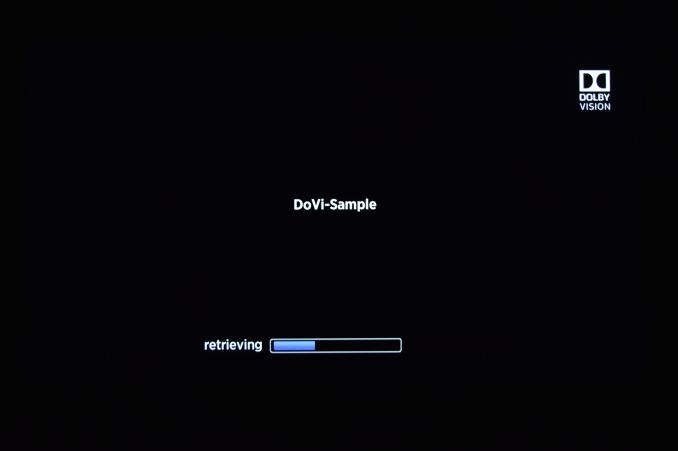

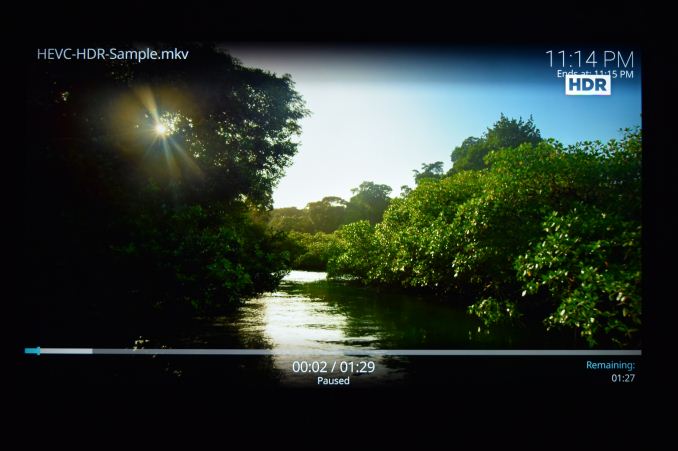
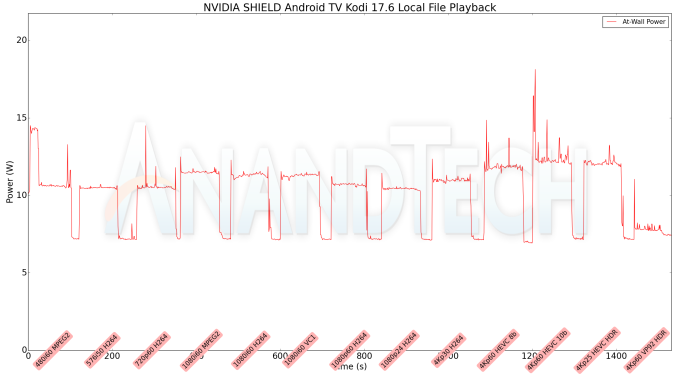
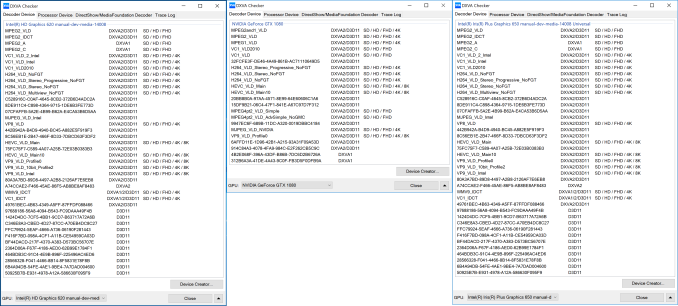
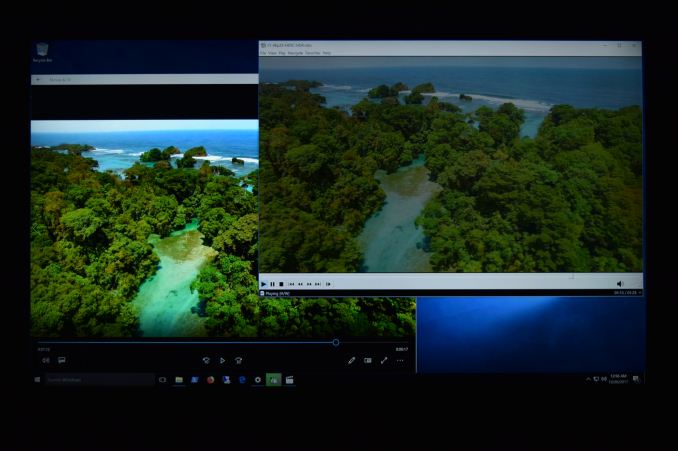
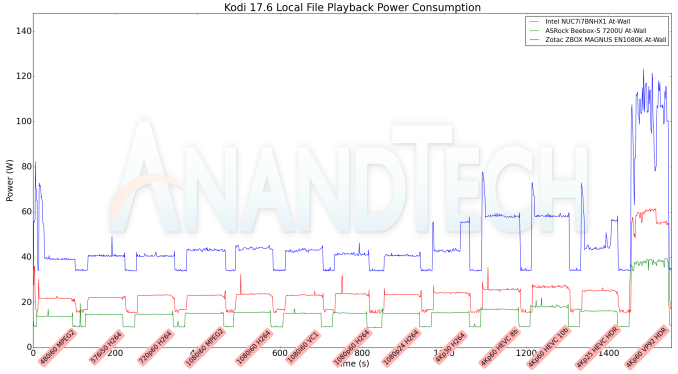










191 Comments
View All Comments
Reflex - Tuesday, January 2, 2018 - link
You are not answering my question:If I play back content that is encoded in DD5.1, 7.1 or Atmos, will your equipment do the proper object placement so that I get a sound effect in the appropriate location?
It is an important detail, if you cannot do that with the material that is available today, your solution is a solution for an audience of one. If it can do that, I am curious how it accomplishes it with what you are describing as essentially a 3.1 setup and with no Dolby or DTS license.
Bullwinkle-J-Moose - Tuesday, January 2, 2018 - link
"what you are describing as essentially a 3.1 setup and with no Dolby or DTS license."-----------------------------------------------------------------------------------------------------------------
The original reference design was 3.0
Moving the Bass speaker to a separate sub cab and calling it a 3.1 system makes zero sense
No Dolby or DTS License is correct
I do not support fake standards forged from a Real Standard
If Dolby and DTS is as good as mine, they should get a License from me
If you wish to play incompatible standards, be my guest
As I have said, I do not support Lesser Quality, incompatible or forged Standards
Dolby Vision is the same in that regard, as I or anyone else can easily create an "Open" Standard that is Visually the Equal of Dolby Vision without need for a Dolby License
Being locked into a proprietary and lesser Standard is "your" choice / not mine!
Reflex - Tuesday, January 2, 2018 - link
Then your setup is good only for you and content you produce, and for the purposes of the article and the discussion thread essentially meaningless. If you can't play back the content that is being produced accurately then it just isn't relevant to the discussion.I'm glad you enjoy your setup, I also enjoy mine.
Bullwinkle-J-Moose - Wednesday, January 3, 2018 - link
"Then your setup is good only for you and content you produce"------------------------------------------------------------------------------------
You are correct
I can produce content for anyone, and they can Lock it down with whichever proprietary standard they want for sale to people like you
My content can be encoded in the standard of the week or whatever "standard" Dolby comes out with next year
Yes, I wanted a system that can master for anyone!
and you want the finished result in a proprietary format of your choice
GOOD FOR YOU!
we are both happy with what we have!
Bullwinkle-J-Moose - Wednesday, January 3, 2018 - link
My Home Audio setups are for creating frontal 2 and 3 channel Audio ImageryI am not interested in surround but I could easily add as many surround channels as the next standard can handle
My focus is on audio production/mixing/mastering/Imaging
yet they are all I need or want for Video / Home Theater as well
All I really want is a great Audio Image in front, so I want what I have and I have what I want!
It's right for ME!
What works for you is also correct
There is no wrong standard here
You can believe in one standard, a hundred standards or none
wiyosaya - Friday, January 5, 2018 - link
I choose C: You are a troll!Aspernari - Tuesday, December 26, 2017 - link
Everything came out of your pocket, except several thousand dollars worth of stuff you recommended because you didn't have to pay for it, so it had no budgetary cost to you.Would you have really bought the $500 receiver instead of a suitable HDMI switch (if you didn't have enough HDMI ports for all your 4k sources) and using ARC or optical out from the TV with your existing receiver?
Your cost/benefit analysis is broken in this article. You keep trying to defend it, but it's not defensible.
ganeshts - Tuesday, December 26, 2017 - link
The $430 receiver was what I wanted in the build. That is what I was ready to spend my budget on.What part of the sentence 'pick and choose from the list' did you not get in the concluding section?
A HDMI switch will not do the job of the AVR.
It is not a matter of defensible or not - I have presented what worked and what didn't, even with the sponsored equipment. I have presented alternatives also. I think $349 for the AVR driving a $700 TV is a very reasonable budget - incidentally, the same amounts that I spent back in 2008 with a Toshiba Regza 46" TV and a Onkyo TX-SR606.
Aspernari - Tuesday, December 26, 2017 - link
Regarding not understanding: I understand just fine. Your choices are poorly considered and presented. I'll restate from elsewhere: You recommend readers buy $200 worth of Bluray-related hardware and deal with BSODs and/or pursue beta drivers, among other issues.Regarding the receiver: I guess you just wanted a new one, since a budget option would have been a TOSLINK cable or other solution to get audio from the TV to your existing receiver, abandoning the HDMI ports on it, and making use of an HDMI switch if you were short on HDMI ports. Total investment of about $40. Sure, you lose some of the functionality of the obsolete receiver (which you could still use fine on 1080p and lower content), but you also save $349 on sale/$430 retail/$464.40ish after tax by not buying a new receiver. Or getting someone to sponsor you.
" I have presented what worked and what didn't, even with the sponsored equipment." - You didn't present anything that I noticed that didn't work with the receiver. You state the inverse actually, "None of the issues encountered in the course of the evaluation presented in this piece could be attributed to the Denon AVR X3400H." - Which may well be true. But you also didn't evaluate the hardware you then recommend people go out and buy anyway, so the entire thing is moot. You're pushing hardware you didn't get your hands on, which just makes this all the more silly.
Imagine publishing a hardware review article, giving something a good "buy" recommendation,but never actually using the product. Oh wait - you just did that.
It's cool that you're going back and making edits based on the response here, but there's really two articles that should have written, crammed into this one:
1) A blog post about stuff you bought and the setup you made, where you can squeeze in your promotional consideration for Denon.
2) The testing you did and the issues you had navigating the current home theater market, focusing on 4k and HDR with HTPCs and high-end settop boxes.
Are you going to actually review the $1000 receiver, or is this article all that they're getting out of it?
edzieba - Tuesday, December 26, 2017 - link
"I guess you just wanted a new one, since a budget option would have been a TOSLINK cable or other solution to get audio from the TV to your existing receiver, "That's... not how things work. At all. Adding an S/PDIF cable is not going to magically allow transport of audio streams that:
a) Are too high bitrate for S/PDIF (which cannot even carry 5.1 LPCM)
b) Were developed decades after the S/PDIF standard
It's as ludicrous and nonsensical a suggestion as installing an IDE cable to allow your SATA motherboard to use m.2 PCIe NVME drives.